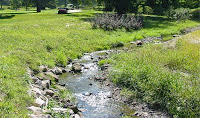
EPA touts Sewer District’s green infrastructure program
Posted by Jared Shepherd
- 10933 Views
- April 22nd, 2011
- in Miscellaneous
- One Comment
In its announcement to promote the use of green infrastructure for environmental and economic benefits, the Northeast Ohio Regional Sewer District’s program was listed a model for other municipalities around the country. Nine other communities across the country also were mentioned by US EPA as leaders in this field.
The goal of using green infrastructure is to reduce stormwater runoff that pollutes streams, creeks, rivers, lakes and coastal waters across the country, and to minimize the amount of stormwater entering sanitary systems, which, in part, will reduce the occurrence of combined sewer overflows (CSO).
The nine other communities identified are Austin, TX; Boston; Denver; Jacksonville, FL; Kansas City; Los Angeles; Puyallup, WA; Syracuse; and Washington, DC.
“This designation helps shape Greater Cleveland’s image from a rustbelt city to an advanced, forward-thinking community,” stated Julius Ciaccia, Executive Director of the Sewer District. “We must fully embrace programs like the Sewer District’s green infrastructure program if we want to attract businesses and people to this water-rich area.”
In December 2010, the Sewer District Board of Trustees agreed to enter into a consent decree with the federal government, which details the long-term plan for reducing raw sewage overflows (CSO) into the environment. The $3 billion, 25-year Project Clean Lake program will reduce the total volume of raw sewage discharges from 4.5 billion gallons to 494 million gallons annually.
In an unprecedented move, the Sewer District and federal government incorporated a wide array of sustainable green infrastructure components into the consent decree, as well. The addition of green infrastructure is notable because it does two things.
First, it gives the District the option to replace the plan’s traditional “gray” infrastructure, like large, deep tunnels, with additional “green” infrastructure (an exchange known as “Green-for-Gray”), which could reduce greenhouse gas emissions and provide multiple benefits to Cleveland neighborhoods.
Secondly, it could reduce the long-term cost of the program while embracing the use of sustainable and environmentally friendly practices. In total, the Sewer District has committed to capturing an additional 44 million gallons of combined sewer overflow through at least $42 million in green infrastructure investments.
“I’m very happy to see that, as a result of the consent decree negotiations, the US EPA has recognized the Sewer District’s progressive green infrastructure initiative as a national model,” stated Kellie Rotunno, Director of Engineering and Construction for the Sewer District. “Some examples of our innovative approach include the use of vacant lots and foreclosed homes for green infrastructure projects. Plus, we’re evaluating the construction of wetlands, bioswales, retention ponds and other green components to manage rainfall before it even makes its way to the combined sewer.”
The Sewer District’s program is progressive in that it requires significant technical components and is extremely vast in its scope. For example, the Sewer District is fully examining its gray infrastructure plan for opportunities to replace traditional approaches with innovative green approaches. These will provide additional green space and redevelopment to the city while cost-effectively addressing the region’s most significant water quality issue.
The Sewer District is not working alone to accomplish a more sustainable Greater Cleveland. The City of Cleveland, Cuyahoga County Land Reutilization Corporation, ParkWorks, Neighborhood Progress Incorporated and the Cleveland Urban Design Collaborative have been working in partnership to tackle the region’s growing vacant and foreclosed properties. The Sewer District will work closely with these partners to ensure the green infrastructure efforts benefit and build on this good work.
“There has been a lot of discussion about regionalism and partnering with other organizations and agencies to improve efficiencies,” stated Ciaccia. “Not only are we a model nationally for green infrastructure, we are a model locally for regionalism and how to work collectively with other groups to achieve a goal that could have long-lasting economic benefit.”
In 2011, the District is completing its Green Infrastructure Feasibility Study. This study will lay out the District’s near-term road map for green infrastructure. The District continues to support innovative on-site stormwater management through its Small-Scale Stormwater Demonstration Projects grants program, and technical assistance on public and private development and redevelopment projects.


Comments ( 1 )
I hope all of the organizations above will look at the proposed Big Box development on Oakwood in light of watershed issues.
The largest watershed for Nine Mile Creek is in Oakwood. Why rip up the largest green space in the inner ring suburbs to build retail we do not need and to destroy watershed?